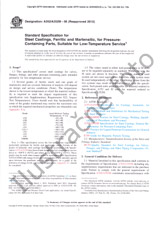Potrebujeme váš súhlas na využitie jednotlivých dát, aby sa vám okrem iného mohli ukazovať informácie týkajúce sa vašich záujmov. Súhlas udelíte kliknutím na tlačidlo „OK“.
ASTM D2170/D2170M-18
Standard Test Method for Kinematic Viscosity of Asphalts
NORMA vydaná dňa 15.12.2018
Informácie o norme:
Označenie normy: ASTM D2170/D2170M-18
Poznámka: NEPLATNÁ
Dátum vydania normy: 15.12.2018
Kód tovaru: NS-910539
Počet strán: 11
Približná hmotnosť: 33 g (0.07 libier)
Krajina: Americká technická norma
Kategória: Technické normy ASTM
Kategórie - podobné normy:
Anotácia textu normy ASTM D2170/D2170M-18 :
Keywords:
asphalt, capillary, kinematic, viscometer, viscosity,, ICS Number Code 91.100.50 (Binders. Sealing materials),93.080.20 (Road construction materials)
Doplňujúce informácie
| Significance and Use | ||||||||||||||||||
|
5.1 The kinematic viscosity characterizes flow behavior. The method is used to determine the consistency of liquid asphalt as one element in establishing the uniformity of shipments or sources of supply. The specifications are usually at temperatures of 60 and 135 °C. Note 3: The quality of the results produced by this standard
are dependent on the competence of the personnel performing the
procedure and the capability, calibration, and maintenance of the
equipment used. Agencies that meet the criteria of Specification
D3666 are generally
considered capable of competent and objective testing, sampling,
inspection, etc. Users of this standard are cautioned that
compliance with Specification D3666 alone does not completely ensure
reliable results. Reliable results depend on many factors;
following the suggestions of Specification D3666 or some similar acceptable
guideline provides a means of evaluating and controlling some of
those factors.
|
||||||||||||||||||
| 1. Scope | ||||||||||||||||||
|
1.1 This test method covers procedures for the determination of kinematic viscosity of liquid asphalts, road oils, and distillation residues of liquid asphalts all at 60 °C [140 °F] and of liquid asphalt binders at 135 °C [275 °F] (see table note, 11.1) in the range from 6 to 100 000 mm2/s [cSt]. 1.2 Results of this test method can be used to calculate viscosity when the density of the test material at the test temperature is known or can be determined. See Annex A1 for the method of calculation. Note 1: This test method is suitable for use at other
temperatures and at lower kinematic viscosities, but the precision
is based on determinations on liquid asphalts and road oils at
60 °C [140 °F] and on asphalt binders at 135 °C [275 °F] only in
the viscosity range from 30 to 6000 mm2/s
[cSt].
Note 2: Modified asphalt binders or asphalt binders that have
been conditioned or recovered are typically non-Newtonian under the
conditions of this test. The viscosity determined from this method
is under the assumption that asphalt binders behave as Newtonian
fluids under the conditions of this test. When the flow is
non-Newtonian in a capillary tube, the shear rate determined by
this method may be invalid. The presence of non-Newtonian behavior
for the test conditions can be verified by measuring the viscosity
with viscometers having different-sized capillary tubes. The
defined precision limits in 11.1 may not be applicable to
non-Newtonian asphalt binders.
1.3 Warning—Mercury has been designated by the United States Environmental Protection Agency (EPA) and many state agencies as a hazardous material that can cause central nervous system, kidney, and liver damage. Mercury, or its vapor, may be hazardous to health and corrosive to materials. Caution should be taken when handling mercury and mercury-containing products. See the applicable product Material Safety Data Sheet (MSDS) or Safety Data Sheet (SDS) for details and the EPA’s website—http://www.epa.gov/mercury/faq.htm—for additional information. Users should be aware that selling mercury, mercury-containing products, or both, in your state may be prohibited by state law. 1.4 The values stated in either SI units or inch-pound units are to be regarded separately as standard. The values stated in each system may not be exact equivalents; therefore, each system shall be used independently of the other. Combining values from the two systems may result in non-conformance with the standard. 1.5 The text of this standard references notes and footnotes that provide explanatory material. These notes and footnotes (excluding those in tables and figures) shall not be considered as requirements of the standard. 1.6 This standard does not purport to address all of the safety concerns, if any, associated with its use. It is the responsibility of the user of this standard to establish appropriate safety, health, and environmental practices and determine the applicability of regulatory limitations prior to use. 1.7 This international standard was developed in accordance with internationally recognized principles on standardization established in the Decision on Principles for the Development of International Standards, Guides and Recommendations issued by the World Trade Organization Technical Barriers to Trade (TBT) Committee. |
||||||||||||||||||
| 2. Referenced Documents | ||||||||||||||||||
|
Odporúčame:
Aktualizácia zákonov
Chcete mať istotu o platnosti využívaných predpisov?
Ponúkame Vám riešenie, aby ste mohli používať stále platné (aktuálne) legislatívne predpisy
Chcete vedieť viac informácií ? Pozrite sa na túto stránku.




 Cookies
Cookies
